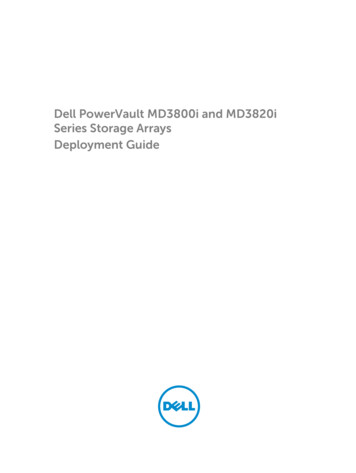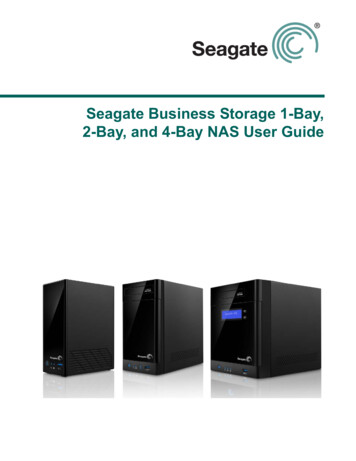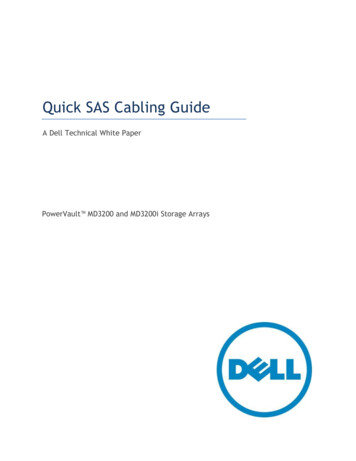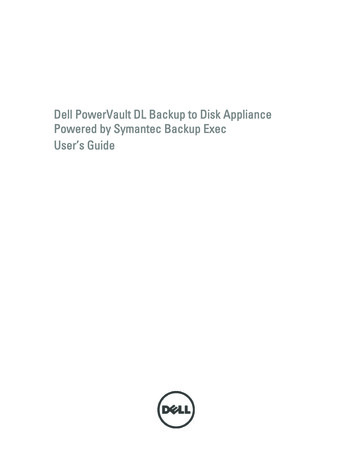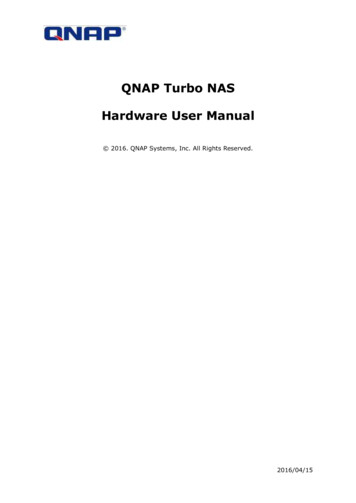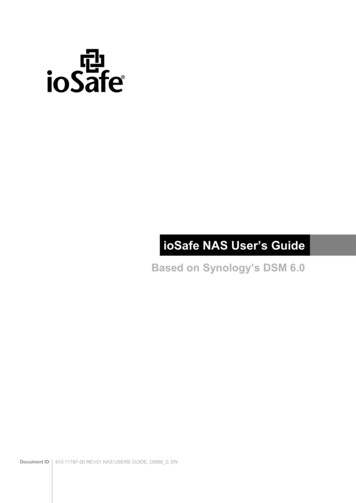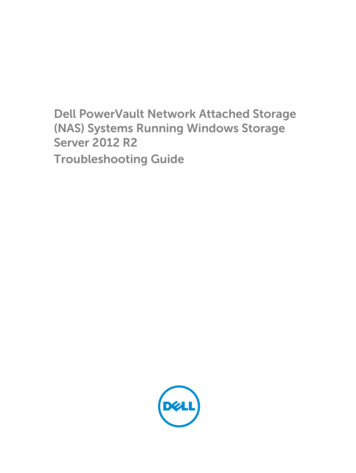
Transcription
Dell PowerVault Network Attached Storage(NAS) Systems Running Windows StorageServer 2012 R2Troubleshooting Guide
Notes, Cautions, and WarningsNOTE: A NOTE indicates important information that helps you make better use of your computer.CAUTION: A CAUTION indicates either potential damage to hardware or loss of data and tells youhow to avoid the problem.WARNING: A WARNING indicates a potential for property damage, personal injury, or death.Copyright 2014 Dell Inc. All rights reserved. This product is protected by U.S. and international copyright andintellectual property laws. Dell and the Dell logo are trademarks of Dell Inc. in the United States and/or otherjurisdictions. All other marks and names mentioned herein may be trademarks of their respective companies.2014 - 02Rev. A00
Contents1 Installation Issues. 5After Replacing The Hard Drives Or Reinstalling The Operating System, The RAIDConfiguration Does Not Match The Factory Configuration And Defaults To RAID 1. 5Error: -5000 Shows Unexpected System Error Message. 5Error: -5001 Shows Invalid System Error Message. 5Error: -5002 Shows Unsupported Hardware Configuration Error.6Error: -5003 Occurred While Creating An Operating System Volume.6Error: -5004 Occurred While Creating An Operating System Volume. 6Error: -5005 Occurred While Creating An Operating System Volume.7Error: -5006 Occurred While Creating An Operating System Volume.7Error: -5007 Occurred While Creating An Operating System Volume. 7Reinstallation Error Message Remains On The LCD. 8Display Log Console Displays A Wrong Date.82 Other Issues.9Deployment Issues. 9Default Password Missing. 9Errors Due To PERC Cards.9Management Issues.9Desktop Displays Incorrect System Information.9Insufficient Disk Space On A Volume Dedicated For iSCSI Virtual Disk.9Turning Off The Firewall.10Update Issues.10Unable to Detect The Dell OpenManage Server Administrator On The System. 103 Getting Help. 11Contacting Dell. 11Related Documentation. 11Locating Your System Service Tag.12Documentation Feedback.12
4
Installation Issues1After Replacing The Hard Drives Or Reinstalling TheOperating System, The RAID Configuration Does NotMatch The Factory Configuration And Defaults To RAID 1DescriptionAfter replacing the hard drives or reinstalling the operating system, the RAIDconfiguration on the system does not match the factory configuration and defaultsto RAID 1.CauseThis issue occurs because the operating system reinstallation media cannot find anoperating system partition of 120 GB or larger on Virtual Disk 0.WorkaroundTo work around this issue, perform the following steps:NOTE: The operating system can only be installed on LUN 0 of the internalcontroller. To configure a RAID configuration other than RAID 1, create avirtual disk with LUN ID 0 before reinstalling the operating system.1.Backup data from all virtual disks.2.Reboot your system and enter the Dell PowerEdge RAID Controller (PERC)BIOS.For more information, see the PERC documentation at dell.com/support/manuals.3.Create a virtual disk with the desired RAID configuration, LUN ID 0, and acapacity of 120 GB or more.4.Reboot the Dell PowerVault NAS system using the operating systemreinstallation media.Error: -5000 Shows Unexpected System Error MessageDescriptionA required system resource cannot be located or is faulty.CauseThis issue occurs because either the operating system reinstallation media, opticaldrive, or the system is in an invalid state.WorkaroundRestart your system and reinstall the operating system reinstallation media. If theissue persists, contact Dell. For more information, see Contacting Dell.Error: -5001 Shows Invalid System Error MessageDescriptionSystem restore is being performed on an unsupported system.CauseThis issue occurs because the operation is not supported on the system.5
WorkaroundTo work around this issue, remove the operating system reinstallation mediaimmediately.Error: -5002 Shows Unsupported HardwareConfiguration ErrorDescriptionThe system is unable to locate a supported RAID controller.WorkaroundTo work around this issue, perform one of the following steps: Ensure that the disk controller card is connected to the internal drives and isproperly seated in the correct slot.For more information about connecting the card, see the Owner’s Manual atdell.com/support/manuals. Enter the PERC BIOS during the operating system boot operation and ensurethat the internal drive controller is functional.For more information, see the PERC documentation at dell.com/support/manuals. Ensure that your system supports an internal drive controller.For information about the internal drive controllers supported on your system,see the system hardware documentation at dell.com/support/manuals.Error: -5003 Occurred While Creating An OperatingSystem VolumeDescriptionInvalid operating system drive configuration. The layout of physical disks to be usedas operating system disks does not meet the required layout for the device.WorkaroundTo work around this issue, perform one of the following steps: Ensure that all drives in the operating system drive slots are correctly attachedand do not have data on them. Physical disks for the operating system must beof the same type and must be greater than 120 GB.Enter the PERC BIOS during the operating system boot operation and ensurethat there are no foreign configurations, no data on the drives, the drives meetthe minimum size requirement, and are fully functioning and accessible.For more information, see the PERC documentation at dell.com/support/manuals.Error: -5004 Occurred While Creating An OperatingSystem VolumeDescriptionDrives in the slots dedicated for operating system drives are empty.WorkaroundTo work around this issue, perform one of the following steps: 6Ensure that all drives in the operating system drive slots are correctly attachedand do not have data on them. Physical disks for the operating system must beof the same type and must meet the minimum size requirements.
Enter the PERC BIOS during the operating system boot operation and ensurethat there are no foreign configurations, no data on the drives, the drives meetthe minimum size requirement, and are fully functioning and accessible.For more information, see the PERC documentation at dell.com/support/manuals.Error: -5005 Occurred While Creating An OperatingSystem VolumeDescriptionDrives in expected operating system slots have existing foreign configurations.WorkaroundTo work around this issue, enter the PERC BIOS during the operating system bootoperation and ensure that there are no foreign configurations, no data on thedrives, the drives meet the minimum size requirement, and are fully functioningand accessible.For more information, see the PERC documentation at dell.com/support/manuals.Error: -5006 Occurred While Creating An OperatingSystem VolumeDescriptionUnable to locate the PowerVault operating system reinstallation media.WorkaroundTo work around this issue, perform one of the following steps: Ensure that the operating system reinstallation media is loaded in the opticaldrive. If the media is present in the drive, the drive may be faulty.For information about troubleshooting the drive, see the Owner’s Manual atdell.com/support/manuals. Ensure that the drive is still functional. Reboot the PowerVault NAS using theoperating system reinstallation media to restart the process.Error: -5007 Occurred While Creating An OperatingSystem VolumeDescriptionA pre-existing virtual disk with LUN ID 0 that is not being used for the NASoperating system has been encountered. The operating system on the PowerVaultNAS system must be on virtual disk 0.WorkaroundTo work around this issue, delete the current virtual disk with LUN ID 0 for theoperating system reinstallation to proceed.1.Backup all data on virtual disk 0 if possible.2.Reboot your system and boot into the PERC controller BIOS during Power OnSelf Test (POST).For more information about booting into the PERC controller BIOS, see thePERC User’s Guide at dell.com/support/manuals.3.Delete the virtual disk with LUN ID 0.7
4.Reboot the PowerVault NAS system using the operating system reinstallationmedia.Reinstallation Error Message Remains On The LCDDescriptionThe last error message remains on the LCD until the operating system issuccessfully reinstalled.WorkaroundTo work around this issue,1.Change the user defined string to the default option or User Defined String.2.Enter the BIOS and select the Embedded Server Management screen.3.Change the option to either default or type a new string.Display Log Console Displays A Wrong DateDescriptionThe display log console displays a wrong date during the operating systemreinstallation process.WorkaroundThis is a known issue and does not affect the system.8
Other Issues2Deployment IssuesDefault Password MissingDescriptionUnable to find the default password of the system.WorkaroundThe default password for your PowerVault storage solution is Stor@ge!Errors Due To PERC CardsDescriptionThis error is caused due to the PERC cards.CauseThis issue occurs because the operating system reinstallation media cannot find anoperating system partition of 120 GB or larger on Virtual Disk 0.WorkaroundTo resolve the issue, see the PERC documentation at dell.com/support/manuals.Management IssuesDesktop Displays Incorrect System InformationDescriptionThe information present on the desktop does not match the actual systeminformation.CauseThis issue occurs because the Dell Desktop System Information Utility does notrefresh automatically. If you make any changes while the system is running, thechanges may not be reflected in real time.WorkaroundTo work around the issue, run the Utility.Insufficient Disk Space On A Volume Dedicated For iSCSI Virtual DiskDescriptionSystem runs out of disk space on a volume dedicated for an iSCSI virtual disk ordevice. System displays a warning or a message that the system is running out ofdisk space on a newly created volume for iSCSI LUN.CauseThis issue occurs due to the Microsoft iSCSI software target architecture.WorkaroundThis message is for your information only. The system ensures the .vhd file is thesame size as the volume it resides on. To find out the actual free space on the disk,view the capacity from the client connected to the disk.9
Turning Off The FirewallYou can turn off the firewall on your system using the: Control Panel Server ManagerTurning Off The Firewall Using The Control PanelTo turn off the firewall from the Control Panel follow the steps given below:1.Launch Control Panel and select System and Security.The System and Security window is displayed.2.In the System and Security window, select Windows firewall.The Windows Firewall screen is displayed.3.Click Turn Windows Firewall on or off.The Customize Settings screen is displayed.4.Choose the appropriate type of network, select Turn off Windows Firewall (not recommended) andclick OK.Turning Off The Firewall Using The Server ManagerTo turn off the firewall from the Serve Manager follow the steps given below:1.Launch Server Manager and navigate to Local Server.2.In the Properties section, under Windows Firewall click Public: On.The Windows Firewall screen is displayed.NOTE: This option will appear as Private: On if you are using a private network.3.Click Turn Windows Firewall on or off.The Customize Settings screen is displayed.4.Choose the appropriate type of network, select Turn off Windows Firewall (not recommended) andclick OK.Update IssuesUnable to Detect The Dell OpenManage Server Administrator On The SystemDescriptionDell OpenManage Server Administrator cannot be found on the system.WorkaroundTo work around this issue, download the latest version of the OpenManage ServerAdministrator from dell.com/support.101.Launch the installer and follow the instructions on the screen.2.After installing the OpenManage Server Administrator, reboot the system.3.After the system boots up, launch OpenManage Server Administrator byselecting the Server Administrator shortcut icon on the desktop.
Getting Help3Contacting DellNOTE: Dell provides several online and telephone-based support and service options. If you do nothave an active Internet connection, you can find contact information on your purchase invoice,packing slip, bill, or Dell product catalog. Availability varies by country and product, and someservices may not be available in your area.To contact Dell for sales, technical support, or customer-service issues:1.Visit dell.com/support.2.Select your country from the drop-down menu on the top left corner of the page.3.For customized support:a) Enter your system service tag in the Enter your Service Tag field.b) Click Submit.The support page that lists the various support categories is displayed.4.For general support:a) Select your product category.b) Select your product segment.c) Select your product.The support page that lists the various support categories is displayed.Related DocumentationWARNING: See the safety and regulatory information that shipped with your system. Warrantyinformation may be included within this document or as a separate document.NOTE: For all PowerEdge and PowerVault documentation, go to dell.com/support/manuals andenter the system Service Tag to get your system documentation.NOTE: For all Dell OpenManage documents, go to dell.com/openmanagemanuals.NOTE: For all operating system documents, go to dell.com/operatingsystemmanuals.NOTE: For all storage controllers and PCIe SSD documents, go to dell.com/storagecontrollermanuals.Your product documentation includes: The Owner’s Manual, which provides information about system features and describes how totroubleshoot the system and install or replace system components. This document is available onlineat dell.com/support/manuals. The rack documentation included with your rack solution describes how to install your system into arack, if required.11
Any media that ships with your system provides documentation and tools for configuring andmanaging your system, including those pertaining to the operating system, system managementsoftware, system updates, and system components that you purchased with your system. The Administrator’s Guide, which provides information about configuring and managing the system.NOTE: Always check for updates on dell.com/support/manuals and read the updates first becausethey often supersede information in other documents.NOTE: When upgrading your system, it is recommended that you download and install the latestBIOS, driver, and systems management firmware on your system from dell.com/support.Locating Your System Service TagYour system is identified by a unique Express Service Code and Service Tag number. The Express ServiceCode and Service Tag are found on the front of the system by pulling out the information tag.Alternatively, the information may be on a sticker on the chassis of the system. This information is usedby Dell to route support calls to the appropriate personnel.Documentation FeedbackIf you have feedback for this document, write to documentation feedback@dell.com. Alternatively, youcan click on the Feedback link in any of the Dell documentation pages, fill up the form, and click Submitto send your feedback.12
Description Dell OpenManage Server Administrator cannot be found on the system. Workaround To work around this issue, download the latest version of the OpenManage Server . Dell PowerVault NAS Systems Running Windows Storage Server 2012 R2 Troubleshooting Guide Dell Inc. .

